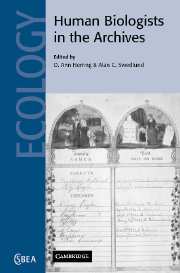 Human Biologists in the Archives
Human Biologists in the Archives Book contents
- Frontmatter
- Contents
- Contributors
- Foreword by Sydel Silverman and Michael A. Little
- Acknowledgements
- 1 Human biologists in the archives: demography, health, nutrition and genetics in historical populations
- 2 The use of archives in the study of microevolution: changing demography and epidemiology in Escazú, Costa Rica
- 3 Anthropometric data and population history
- 4 For everything there is a season: Chumash Indian births, marriages, and deaths at the Alta California missions
- 5 Children of the poor: infant mortality in the Erie County Almshouse during the mid nineteenth century
- 6 Worked to the bone: the biomechanical consequences of ‘labor therapy’ at a nineteenth century asylum
- 7 Monitored growth: anthropometrics and health history records at a private New England middle school, 1935–1960
- 8 Scarlet fever epidemics of the nineteenth century: a case of evolved pathogenic virulence?
- 9 The ecology of a health crisis: Gibraltar and the 1865 cholera epidemic
- 10 War and population composition in Åland, Finland
- 11 Infectious diseases in the historical archives: a modeling approach
- 12 Where were the women?
- 13 Malnutrition among northern peoples of Canada in the 1940s: an ecological and economic disaster
- 14 Archival research in physical anthropology
- Index
- References
6 - Worked to the bone: the biomechanical consequences of ‘labor therapy’ at a nineteenth century asylum
Published online by Cambridge University Press: 12 August 2009
- Frontmatter
- Contents
- Contributors
- Foreword by Sydel Silverman and Michael A. Little
- Acknowledgements
- 1 Human biologists in the archives: demography, health, nutrition and genetics in historical populations
- 2 The use of archives in the study of microevolution: changing demography and epidemiology in Escazú, Costa Rica
- 3 Anthropometric data and population history
- 4 For everything there is a season: Chumash Indian births, marriages, and deaths at the Alta California missions
- 5 Children of the poor: infant mortality in the Erie County Almshouse during the mid nineteenth century
- 6 Worked to the bone: the biomechanical consequences of ‘labor therapy’ at a nineteenth century asylum
- 7 Monitored growth: anthropometrics and health history records at a private New England middle school, 1935–1960
- 8 Scarlet fever epidemics of the nineteenth century: a case of evolved pathogenic virulence?
- 9 The ecology of a health crisis: Gibraltar and the 1865 cholera epidemic
- 10 War and population composition in Åland, Finland
- 11 Infectious diseases in the historical archives: a modeling approach
- 12 Where were the women?
- 13 Malnutrition among northern peoples of Canada in the 1940s: an ecological and economic disaster
- 14 Archival research in physical anthropology
- Index
- References
Summary
Introduction
During the nineteenth century in North America, the erection of custodial institutions, such as prisons and asylums for the mentally ill, initiated a legacy of long-term inmate care, structured around social and medical philosophy, which has persisted to the present day (Dwyer 1987; Foucault 1965; Grob 1994; Phillips 2001; Rothman 1995). The historiography of those institutions demonstrates that inmates were viewed as social deviants and potentially threatening to the fabric of society. As such, the purpose of the emergent nineteenth-century institutions, from prisons to asylums, was to attempt to reform the inmates for possible return to mainstream society. In this effort, inmates' lives were structured around contemporary medical and sociological concepts of normalcy (Dwyer 1987; Ferguson 1994; Rothman 1995). In the attempt to institute normalcy, asylum superintendents hoped to shepherd inmates' habits away from deviant behaviors and within the sphere of normalcy. In this atmosphere, inmates of long-term custodial institutions were exposed to regimens established to bring about normalcy, in many cases, for their entire adult lives. The aim of this study is to examine some of the biological consequences, in the skeletal record, to inmates of long-term custodial institutions who were exposed to socially and medically prescribed regimens. Some basic questions this study poses include: How can the skeletal record be utilized to test hypotheses generated from the historical record? Since institutional inmates were virtually a voiceless group, how can we recover their day-to-day experiences?
- Type
- Chapter
- Information
- Human Biologists in the ArchivesDemography, Health, Nutrition and Genetics in Historical Populations, pp. 96 - 129Publisher: Cambridge University PressPrint publication year: 2002


